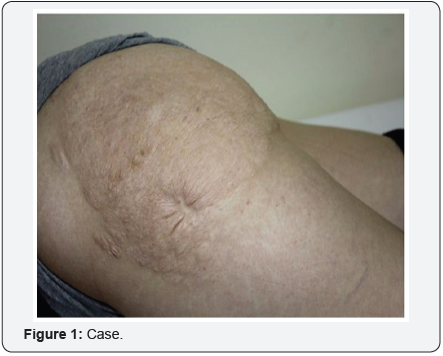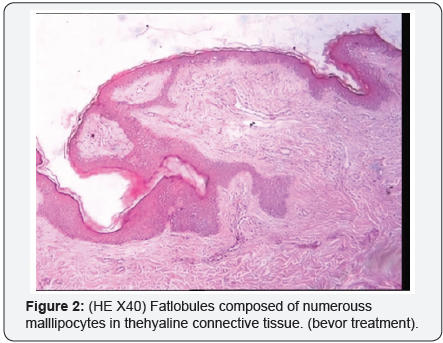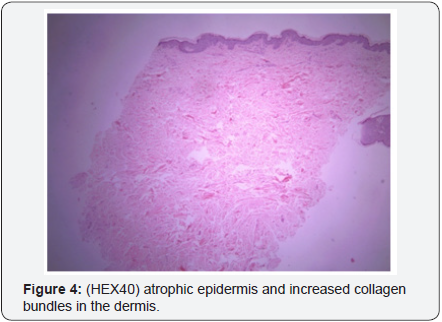Juniper Publishers- Open Access Journal of Case Studies
Efficacy of Platelet Rich Plasma in the Treatment of lipoatrophy
Authored by Zerrin Ogretmen
Introduction and Objectives
Localized involutional lipoatrophy (LIL) is a rare a symptomatic, idiopatic form of localized lipoatrophy seen in dermatological practice. LIL usually presents as a solitary, localized, well demarcated, fresh colored, asymptomatic, atrophic depression. It frequently, develops on the injection areas [1,2].
Platelet-rich plasma (PRP) is highly concentrated auto logous solution of plasma prepared from a patient’s own blood.PRP contains platelets that are purported to release numerous growth factors that may be valuable in numerous dermatologic applications. We know the addition of platelets and their associated growth factors opened new possibilities, for the treatment of chronic skin ulcers. Therefore the application of PRP; for lipoatrophy treatment is a new treatment [3-6].
Material and Methods

18-year old female patient was admitted to our outpatient clinic with thinning and disfigurement complaint of her skin on her hip (Figure 1).

She said that her problem started when she was a month old baby. The lesion was 0.5cm in diameter and increased overtime. By dermatological examination; 25cm diameter, sharply demarcated, skin color, depressed, a trophic plaques were observed on left gluteal area. She had no history of any injury or injection or operation at the site. Skin biopsy was consistent with the results of lipoatrophy (Figure 2).
PRP is prepared in various forms. Pure PRP is the most commonly used form consisting of a buffy coat with a large number of platelets with little leukocytes being collected. PRP contains various growth factors contained in alpha granules and dense granules. Alpha granules contain seven fundamental growth factors: the platelet derived growth factors (PDGFaa, PDGFbb, and PDGFab), transforming growth factor beta (TGFβ1 and 2), epithelial growth factor (EGF), and vascular endothelial growth factor (VEGF) [4].
İn recent years PRP is frequently used in cosmetic dermatology. Good outcomes for other dermatological indications such as skin ulcers and alopecia have been reported in studies [6]. It is used more often in procedures such as fat grafting or soft tissue augmentation due to the slower secretion over a longer time period [7].
Results
Localized involutional lipoatrophy (LIL) is a rare a symptomatic, idiopathic form of localized lipoatrophy. Most of the patients are women. Lesion is frequently solitary. Mostly buttocks and proximal extremities are affected. Our patients also had the same properties. Laboratory examination showed normal findings; except Total IgE: 294U/ml (normal: 0-87), eosinophils 20.2% (normal: 0.8-4). Histological examination showed fat lobules composed of small lipocytes in the hyaline connective tissue. LIL is characterized bynon inflammatory focal loss of subcutaneous tissue [8].
Conclusion
In the last decade, several smaller studies were performed, demonstrating the positive effect of PRP on wound healing, the formation of granulation tissue and neo-vascularization [4,6].
After activation, platelets synthetize and secrete a number of cytokines and growth factors, the most important ones being platelet-derived growth factor (PDGF), transforming growth factor beta-1 (TGF-β1), vascular endothelial growth factor (VEGF) and epidermal growth factor (EGF). In one study, PRP and fat graft were used to dilate the gluteal augmentation [7].

A total of 10 sessions PRP was administered every 2 weeks (Figure 3). The lesion was clinically resolved. Are peat biopsy was taken. Atrophy in the fatty tissue continued. Tissue loss was improved probably because PRP stimulated endothelial cells, fibroblasts, mesenchimal cells, smooth muscle cells for repairment (Figure 4). We treated depression in the gluteal region, not lipoatrophy, with PRP therapy. We didn’t use a fat graft. We used only PRP.

For more Open Access Journals in JuniperPublishers please click on:
https://www.linkedin.com/company/juniper-publishers
For more articles in Open Access Journal of Case Studies please
click on: https://juniperpublishers.com/jojcs/
To know more about Open Access Journals Publishers
To read more…Fulltext please click on: https://juniperpublishers.com/jojcs/JOJCS.MS.ID.555622.php




No comments:
Post a Comment